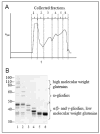Novel immune response to gluten in individuals with schizophrenia
- PMID: 19748229
- PMCID: PMC2856786
- DOI: 10.1016/j.schres.2009.08.009
Novel immune response to gluten in individuals with schizophrenia
Abstract
A link between celiac disease and schizophrenia has been postulated for several years, based primarily on reports of elevated levels of antibody to gliadin in patients. We sought to examine the proposed connection between schizophrenia and celiac disease by characterizing the molecular specificity and mechanism of the anti-gliadin immune response in a subset of individuals with schizophrenia. Blood samples from individuals with schizophrenia and elevated anti-gliadin antibody titer were examined for celiac disease-associated biomarkers, including antibodies to transglutaminase 2 (TG2) enzyme and deamidated gliadin peptides, as well as the HLA-DQ2 and -DQ8 MHC genes. The anti-gliadin antibody response was further characterized through examination of reactivity towards chromatographically separated gluten proteins. Target proteins of interest were identified by peptide mass mapping. In contrast to celiac disease patients, an association between the anti-gliadin immune response and anti-TG2 antibody or HLA-DQ2 and -DQ8 markers was not found in individuals with schizophrenia. In addition, the majority of individuals with schizophrenia and anti-gliadin antibody did not exhibit antibody reactivity to deamidated gliadin peptides. Further characterization of the antibody specificity revealed preferential reactivity towards different gluten proteins in the schizophrenia and celiac disease groups. These findings indicate that the anti-gliadin immune response in schizophrenia has a different antigenic specificity from that in celiac disease and is independent of the action of transglutaminase enzyme and HLA-DQ2/DQ8. Meanwhile, the presence of elevated levels of antibodies to specific gluten proteins points to shared immunologic abnormalities in a subset of schizophrenia patients. Further characterization and understanding of the immune response to gluten in schizophrenia may provide novel insights into the etiopathogenesis of specific disease phenotypes.
Copyright (c) 2009 Elsevier B.V. All rights reserved.
Figures




Similar articles
-
Markers of gluten sensitivity and celiac disease in recent-onset psychosis and multi-episode schizophrenia.Biol Psychiatry. 2010 Jul 1;68(1):100-4. doi: 10.1016/j.biopsych.2010.03.021. Epub 2010 May 14. Biol Psychiatry. 2010. PMID: 20471632
-
Lack of serologic evidence to link IgA nephropathy with celiac disease or immune reactivity to gluten.PLoS One. 2014 Apr 14;9(4):e94677. doi: 10.1371/journal.pone.0094677. eCollection 2014. PLoS One. 2014. PMID: 24732864 Free PMC article.
-
Serologic assay for diagnosis of celiac disease based on a patient-derived monoclonal antigliadin antibody.Gastroenterology. 2015 Nov;149(6):1530-1540.e3. doi: 10.1053/j.gastro.2015.07.008. Epub 2015 Jul 21. Gastroenterology. 2015. PMID: 26208894
-
Transglutaminase 2 and Transglutaminase 2 Autoantibodies in Celiac Disease: a Review.Clin Rev Allergy Immunol. 2019 Aug;57(1):23-38. doi: 10.1007/s12016-016-8557-4. Clin Rev Allergy Immunol. 2019. PMID: 27263022 Review.
-
Celiac disease: risk assessment, diagnosis, and monitoring.Mol Diagn Ther. 2008;12(5):289-98. doi: 10.1007/BF03256294. Mol Diagn Ther. 2008. PMID: 18803427 Review.
Cited by
-
Markers of Celiac Disease and Gluten Sensitivity in Children with Autism.PLoS One. 2013 Jun 18;8(6):e66155. doi: 10.1371/journal.pone.0066155. Print 2013. PLoS One. 2013. PMID: 23823064 Free PMC article.
-
Reducing the Immunogenic Potential of Wheat Flour: Silencing of Alpha Gliadin Genes in a U.S. Wheat Cultivar.Front Plant Sci. 2020 Feb 25;11:20. doi: 10.3389/fpls.2020.00020. eCollection 2020. Front Plant Sci. 2020. PMID: 32161604 Free PMC article.
-
The epidemiologic evidence linking autoimmune diseases and psychosis.Biol Psychiatry. 2014 Feb 15;75(4):300-6. doi: 10.1016/j.biopsych.2013.09.023. Epub 2013 Oct 3. Biol Psychiatry. 2014. PMID: 24199668 Free PMC article. Review.
-
Deciphering the complexities of the wheat flour proteome using quantitative two-dimensional electrophoresis, three proteases and tandem mass spectrometry.Proteome Sci. 2011 Feb 11;9:10. doi: 10.1186/1477-5956-9-10. Proteome Sci. 2011. PMID: 21314956 Free PMC article.
-
Genome-wide genetic and transcriptomic investigation of variation in antibody response to dietary antigens.Genet Epidemiol. 2014 Jul;38(5):439-46. doi: 10.1002/gepi.21817. Genet Epidemiol. 2014. PMID: 24962563 Free PMC article.
References
-
- Alaedini A, Green PH. Narrative review: celiac disease: understanding a complex autoimmune disorder. Ann Intern Med. 2005;142:289–298. - PubMed
-
- Alaedini A, Green PH. Autoantibodies in celiac disease. Autoimmunity. 2008;41:19–26. - PubMed
-
- Alaedini A, Okamoto H, Briani C, et al. Immune cross-reactivity in celiac disease: anti-gliadin antibodies bind to neuronal synapsin I. J Immunol. 2007;178:6590–6595. - PubMed
-
- Bender L. Childhood schizophrenia. Psychiatr Q. 1953;27:663–681. - PubMed
-
- Briani C, Samaroo D, Alaedini A. Celiac disease: from gluten to autoimmunity. Autoimmun Rev. 2008;7:644–650. - PubMed
Publication types
MeSH terms
Substances
Grants and funding
LinkOut - more resources
Full Text Sources
Other Literature Sources
Medical
Research Materials

